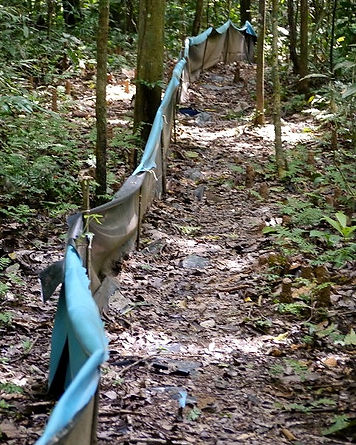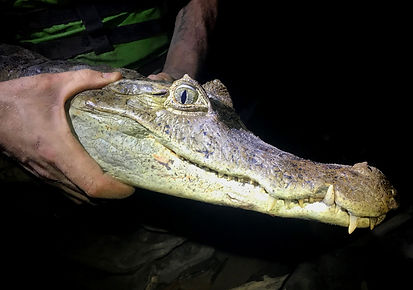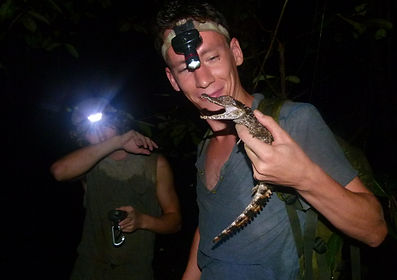

Herpetofauna
Research Team
Photo: Luke Pembroke
Understanding the diversity, distribution, population dynamics, and optimal conservation strategies of forest-dwelling amphibians and reptiles in Amazonian Peru
Fauna Forever's herpetology research program featuring Head Field Research Coordinator, Chris Ketola. Video: Foggy Lens Productions
Herpetofauna Team Objectives
The Herpetofauna Research Team is tasked with the following principle scientific and conservation objectives: (i) to establish baseline datasets on the diversity and abundance of over 200 species of reptiles and amphibians at numerous field sites across the Madre de Dios region of Amazonian Peru; (ii) to monitor changes in these populations over time scales ranging from months to decades; (iii) to compare and contrast sites in terms of reptile and amphibian diversity, community structure, abundance and population density; (iv) to understand and explain differences between sites and over time with respect to environmental and anthropogenic variables such as climate (temperature, rainfall), forest type (terra-firme, floodplain), land-use categories (protected areas, indigenous or native community forest, ecotourism concessions, timber and non-timber extractive reserves, bushmeat hunting areas, and forests surrounded by or immediately adjacent to agricultural and cattle ranching areas), and underlying human-related disturbance as measured by distance from towns and villages, roads, and large navigable rivers; (v) to identify reptile and amphibian populations or communities that are changing particularly rapidly and the likely underlying causes of this change; (vi) to provide forest land owners and managers with information about the conservation status of the herpetofauna community in their forest; (vii) to educate the general public in Peru and worldwide about Neotropical herpetofauna; and ultimately; and ultimately (viii) to promote conservation actions at the species, site and landscape level that will help conserve the reptiles and amphibians of Peru

A 2m Spectacled Caiman (Caiman crocodilus) being held by herpetofauna team coordinators. (Photo: Sam Reitsma)
.jpg)
A Green anaconda (Eunectes murinus)
Photo: Ian Markham
Methods Used
.jpg)
A male Giant monkey frog (Phyllomedusa bicolor)
Photo: Jason Kopp

A typical 30m-long pitfall trap line containing 4 bucket traps. Photo: Kanta
%20small.jpg)
Slender-legged tree frog (Osteocephalus taurinus). Photo: Fabian Muhlberger
The primary sampling methods we use to study amphibian and reptile species in the Peruvian Amazon include line transects, intensive quadrat searches, opportunistic surveys of specific sometimes seasonal habitats, pitfall trap lines, and caiman surveys by boat. In a typical week, 5 to 6 nights are dedicated to line transect, quadrat or opportunistic sampling and 1 to 2 nights to caiman surveys in large rivers or streams. Once established, pitfall traps are actively functioning at active field sites on a daily basis. Line transect sampling is conducted within 1-hectare plots consisting of eleven evenly-spaced 100m long transect lines. Each research site contains 2-4 transect sampling plots. Quadrat sampling plots are conducted within separate 1-hectare plots, each divided into 10x10m quadrats or squares. Each research site contains 1-2 quadrat sampling plots. Opportunistic sampling sessions are conducted within seasonally available locations within a site, such as temporarily flooded forests, swamps, bamboo thickets, mixed agriculture-forest mosaics, and micro-habitats that require rapid biodiversity assessments. Specimen specific variables such as perpendicular distance to transect line, micro-habitat features and specimen height are recorded for each individual encountered. Pitfall trap lines consist of four pitfall traps (70-litre buckets) spaced 10m apart for a total distance of 30m per trap line. Temporary plastic barriers are placed above these traps to funnel terrestrial herpetofauna and occasionally small mammals into these bucket traps. Each research site has 2 to 4 pitfall trap lines. During pitfall-based surveys, specimens are captured and placed separately into appropriate bags for later processing (i.e. careful identification and collection of morphological data) back at camp, after which they are released near to the point of capture. Selected species considered to be too delicate are not taken back to camp, and instead are identified, processed, and released in the field. The morphometric data collected on each captured individual include age class, sex, snout to vent length (SVL), total body length (TBL) and weight. Caiman sampling on navigable rivers is conducted by boat and on streams by foot. River surveys are conducted along transects that are approximately 4 linear kilometres in length. At each site, there are between 2 to 4 of these river transects. Stream surveys are also conducted within transects, however the length varies greatly depending on the characteristics of each stream. The number of stream transects varies greatly between sites (mean 2, range 0-4). Caimans are captured when possible and processed at the point of capture, either within the boat or on the stream bank. Morphological data collected include age class, sex, SVL, TBL and weight. In addition, a Passive Integrated Transponder (PIT) tag is inserted in the tail area of each caiman to assist with mark/recapture studies. Caimans are released immediately following processing at the site of capture. In addition, data on habitat variables in the vicinity of transects, quadrats, pitfall trap lines and opportunistic sampling areas are collected using 0.05-ha Modified Gentry plots. All of the above data is used to assess diversity, relative abundance and population density of species using standard analytical protocols, as well as occupancy modelling to predict species distributions and habitat suitability. Data analysis and visualisation programs that we use include R, Distance, QGIS, SPSS, Mark, and Estimates.
Summary of a Typical Day on the Herp Team
Morning work normally stars off after breakfast (8am) and begins with checking pitfall trap lines for any specimens that may have been caught overnight. Upon returning to camp, any specimens captured during the previous night of transect or quadrat sampling are processed along with the specimens found in the pitfall trap lines. Team members then release these specimens in close proximity to the location of their original capture. At this point, the team either returns to camp to enter data from previous sampling sessions into laptop computers or they head straight out to conduct diurnal (daytime) sampling of transect lines or quadrats. After lunch (1pm) and a brief rest period, afternoon activities may include transect or quadrat sampling sessions, research plot maintenance, data entry and review, or collection of habitat data in and around sample stations using 0.05-ha Modified Gentry plots. Nocturnal sampling sessions begin either before dinner (6pm) or after dinner (8pm) and last between 2 to 4 hours, with the team returning to camp between 9pm and midnight. These sampling sessions consist of either line transects, quadrat counts, opportunistic surveys or caiman transects. All research schedules and activities are subject to change at the discretion of the team coordinator.
.jpg)
Tree runner (Plica umbra).
Photo: Ian Markham
Field Course Internship
This option is for those people interested in learning or improving research techniques and related field skills for studying amphibians and reptiles in terrestrial and freshwater habitats. We offer Beginner, Intermediate, Advanced and Master-level course segments in terrestrial sampling methods, river- and stream-based caiman survey techniques (not all research sites will be suitable for caiman surveys), species identification, and datasheet and database management methods. Each course segment is expected to take approximately 2 weeks for interns to complete, however this is not a set expectation as we understand individuals learn certain skills at different speeds. Progression to the next stage of the course will be at the discretion of the team's head research coordinator. Participants who successfully complete the full course (or the three most advanced segments), with an aptitude for bird research techniques will be considered for opportunities to join our Skilled Research Internship program or be considered for an Assistant Research Coordinator position.
1. Introductory Course Segment - Neotropical Amphibians and Reptiles
Duration: 2 weeks
Description: Participants will learn (i) the theories behind using line transect, quadrat leaf litter, opportunistic and pitfall line survey methods to obtain relevant population and community structure data; (ii) the theory behind using river based caiman survey methods to obtain population and specimen mark/recapture data; (iii) the theory behind identifying reptiles and amphibians in the hand using relevant literature, guides and dichotomous keys; (iv) the theory behind safely capturing reptiles and anurans during field surveys; (v) the theory behind safe and ethical methods for handling and transporting reptiles and amphibians for the purpose of recording morphometric data; (vi) what categories of morphometric data are recorded from each captured specimen including age class, sex, snout to vent length (SVL), total body length (TBL) and weight; (vii) the theory behind the safe capture and handling of potentially dangerous reptiles such as caimans and venomous snakes; (viii) the methods used to safely insert passive integrated transponder (PIT) tags into captured caimans; (ix) the theory and practise behind the habitat variables that we collect in and around each sample station (i.e. vegetation plots).
%20Small.jpg)
A young Forest tegu (Tupinambis cuzcoensis).
Photo: Chris Kirkby

Amazon ringed snake (Rhinobothryum lentiginosum). Photo: Amanda Guercio
2. Intermediate Course Segment - Neotropical Amphibians and Reptiles
Duration: 2 weeks
Description: Participants will learn (i) to record specimen encounter data collected during line transect, quadrat leaf litter and opportunistic surveys while closely supervised; (ii) to perform research plot maintenance using tools such as machetes under supervision; (iii) to record specimen encounter data collected during river caiman surveys using handheld GPS devices under supervision; (iv) to identify reptiles and amphibians in the hand using relevant literature, guides and dichotomous keys to an accuracy of 75%; (v) to safely capture live non-venomous reptiles and anurans during field surveys under close supervision; (vi) to safely handle and place into bags live reptiles and amphibians under close supervision; (vii) to record morphometric data from captured live non-venomous reptiles and amphibians under close supervision; (viii) to handle venomous snakes using protective equipment (if specimens are encountered) under close supervision; (ix) to safely hold captured caimans for the purpose of recording morphometric data under close supervision; (x) to record morphometric data including SVL, TBL, weight and sex from captured caimans under close supervision; (xi) to enter data about each sampling session and specimen encounter into our laptop computers, under close supervision, including data review techniques to catch errors and increase quality of the dataset; (xii) the theory behind unbounded versus bounded transects and how to analyze and interpret this data; and (xiii) the theory and practise behind the habitat variables that we collect in and around each sample station (i.e. vegetation plots), including techniques to analyse this data.

Members of the herpetofauna team processing amphibians near a transect line.
Photo: Roman Christen

Spectacled caiman (Caiman crocodilus) in a secure head hold while being measured. Photo: Chris Ketola
3. Advanced Course Segment - Neotropical Amphibians and Reptiles
Duration: 2 weeks
Description: Participants will learn (i) to record specimen encounter data collected during line transect, quadrat leaf litter and opportunistic surveys with little supervision; (ii) to perform maintenance on existing plots and open new research plots using tools such as machetes with little supervision; (iii) to record specimen encounter data collected during river caiman surveys using handheld GPS devices with little supervision; (iv) to identify reptiles and amphibians in the hand using relevant literature, guides and dichotomous keys to an accuracy of 90%; (v) to safely capture live non-venomous reptiles and anurans during field surveys with little supervision; (vi) to safely handle and place into bags live reptiles and amphibians with little supervision; (vii) to record morphometric data from captured live non-venomous reptiles and amphibians with little supervision; (viii) to handle and bag venomous snakes using protective equipment (if specimens are encountered) with reduced supervision; (ix) to use powerful spotlights to detect caiman eye-shine during river surveys; (x) to safely hold and manipulate captured caimans for the purpose of recording morphometric data with reduced supervision; (x) to record morphometric data including SVL, TBL, weight and sex from captured caimans with little supervision; (xi) to enter data about each sampling session and specimen encounter into our laptop computers, with only little supervision, including data review techniques to catch errors and increase quality of the dataset; (xii) to perform simple analysis of line transect data using either Distance or R; and (xiii) collect data relating to habitat variables in and around each sample station (i.e. vegetation plots), with limited supervision.

Yellow-tailed cribo (Drymarchon corais).
Photo: Patrick Campbell

An intern holding a Rainbow boa (Epicrates cenchria) just before it is released back into the forest.
Photo: Chris Ketola
4. Master Course Segment - Neotropical Amphibians and Reptiles
Duration: 2 weeks
Description: Participants will build further competence in all of the key components and skills taught in earlier course segments (see above) and will attain a degree of professionalism in each case that by the end of this 8-week course they should be able to independently undertake all aspects of our herpetofauna research protocols (excluding free handling of venomous snakes) with only very little supervision from our herpetofauna team coordinators (with supervision focused only on health and safety, species identification, and data entry and checking).

Herp team members about to measure a Bushmaster (Lachesis muta), with Alberto, our experienced coordinator, safely in control of the head. Photo: Alberto Garcia-Ayachi.
%20small.jpg)
Horned Forest Tree Frog (Dendropsophus kamagarini).
Fabian Muhlberger
Fauna Forever's caiman research project featuring Thesis Project Intern and Assistant Coordinator, Hallie Cowan Barrera.
Video: Foggy Lens Productions
Thesis Project Internship
If you are a student looking to undertake an official thesis or dissertation project on Neotropical amphibians or reptiles in the Peruvian Amazon and would like to benefit from our expertise and know-how, then this option is for you. You can find out more on the Thesis Project Internship page. We are able to offer support and advice to students regarding project design, implementation and data analysis, along with close supervision from our research coordinators. We have even identified some potential research questions that could be developed into thesis projects, although we are also open to ideas and questions from student applicants. Undergraduate level projects should ideally be planned to be undertaken over a minimum 6-week period. Any shorter and there is no guarantee, in our experience, that sufficient quality data would be collected. Our management team can also provide official supervision and reporting as may be required by colleges and universities. Due to the specific nature of each student's thesis project idea, final costs will be agreed following discussions with the Fauna Forever research team.
%20small_J.jpg)
Volunteer making the most of a photo opportunity while a young caiman is being released back into a stream in the Peruvian Amazon. Photo: Stefan Harrison

A Yellow-footed tortoise (Chelonoidis denticulatus)
being carefully measured. Photo: Kanta
Recommended Reading
Field Guides

Reptiles and Amphibians of the Amazon. By: Richard D. Bartlett et al. (2003)
Published Articles
Duellman (1988) Patterns of species diversity in anuran amphibians in the
American tropics. Annals of the Missouri Botanical Garden 75(1): 79-104.
Herron (1991) Growth rates of black caiman Melanosuchus niger and
spectacled caiman Caiman crocodilus, and the recruitment of breeders in
hunted caiman populations. Biological Conservation 55(1): 103-113.
Doan (2002) Microgeographic variation in species composition of the
herpetofaunal communities of the Tambopata Region, Peru. Biotropica 34(1):
101-117.
Doan (2003) Which methods are most effective for surveying rain forest
herpetofauna? Journal of Herpetology 37(1): 72–81.
Doan (2004) Extreme weather events and the vertical microhabitat of rain
forest anurans. Journal of Herpetology 38(3): 422–425.
Ribeiro-Junior (2008) Evaluating the effectiveness of herpetofaunal sampling
techniques across a gradient of habitat change in a tropical forest
landscape. Journal of Herpetology 42(4): 733–749.
von May (2008) Current state of conservation knowledge on threatened
amphibian species in Peru. Tropical Conservation Science 1(4): 376-396.
von May (2008) Species diversity and conservation status of amphibians in
Madre de Dios, southern Peru. Herpetological Conservation and Biology 4(1):
14-29.
Santos et al. (2009) Amazonian amphibian diversity is primarily derived from
late Miocene Andean lineages. PLoS Biology 7(3).




















